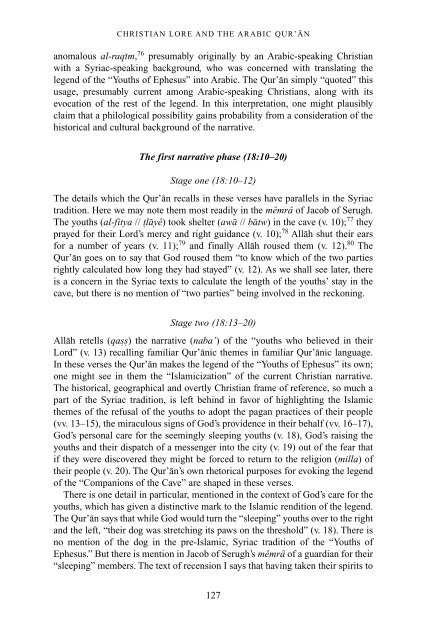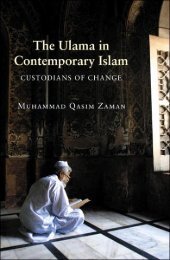The Qur'an in its historical context (pdf - Islam and Christian-Muslim ...
The Qur'an in its historical context (pdf - Islam and Christian-Muslim ...
The Qur'an in its historical context (pdf - Islam and Christian-Muslim ...
You also want an ePaper? Increase the reach of your titles
YUMPU automatically turns print PDFs into web optimized ePapers that Google loves.
CHRISTIAN LORE AND THE ARABIC QUR’AN<br />
anomalous al-raqim, 76 presumably orig<strong>in</strong>ally by an Arabic-speak<strong>in</strong>g <strong>Christian</strong><br />
with a Syriac-speak<strong>in</strong>g background, who was concerned with translat<strong>in</strong>g the<br />
legend of the “Youths of Ephesus” <strong>in</strong>to Arabic. <strong>The</strong> Qur’an simply “quoted” this<br />
usage, presumably current among Arabic-speak<strong>in</strong>g <strong>Christian</strong>s, along with <strong>its</strong><br />
evocation of the rest of the legend. In this <strong>in</strong>terpretation, one might plausibly<br />
claim that a philological possibility ga<strong>in</strong>s probability from a consideration of the<br />
<strong>historical</strong> <strong>and</strong> cultural background of the narrative.<br />
<strong>The</strong> first narrative phase (18:10–20)<br />
Stage one (18:10–12)<br />
<strong>The</strong> details which the Qur’an recalls <strong>in</strong> these verses have parallels <strong>in</strong> the Syriac<br />
tradition. Here we may note them most readily <strong>in</strong> the mêmrâ of Jacob of Serugh.<br />
<strong>The</strong> youths (al-fitya // tlayê) took shelter (awa // batw) <strong>in</strong> the cave (v. 10); 77 they<br />
prayed for their Lord’s mercy <strong>and</strong> right guidance (v. 10); 78 Allah shut their ears<br />
for a number of years (v. 11); 79 <strong>and</strong> f<strong>in</strong>ally Allah roused them (v. 12). 80 <strong>The</strong><br />
Qur’an goes on to say that God roused them “to know which of the two parties<br />
rightly calculated how long they had stayed” (v. 12). As we shall see later, there<br />
is a concern <strong>in</strong> the Syriac texts to calculate the length of the youths’ stay <strong>in</strong> the<br />
cave, but there is no mention of “two parties” be<strong>in</strong>g <strong>in</strong>volved <strong>in</strong> the reckon<strong>in</strong>g.<br />
Stage two (18:13–20)<br />
Allah retells (qass) the narrative (naba’) of the “youths who believed <strong>in</strong> their<br />
Lord” (v. 13) recall<strong>in</strong>g familiar Qur’anic themes <strong>in</strong> familiar Qur’anic language.<br />
In these verses the Qur’an makes the legend of the “Youths of Ephesus” <strong>its</strong> own;<br />
one might see <strong>in</strong> them the “<strong>Islam</strong>icization” of the current <strong>Christian</strong> narrative.<br />
<strong>The</strong> <strong>historical</strong>, geographical <strong>and</strong> overtly <strong>Christian</strong> frame of reference, so much a<br />
part of the Syriac tradition, is left beh<strong>in</strong>d <strong>in</strong> favor of highlight<strong>in</strong>g the <strong>Islam</strong>ic<br />
themes of the refusal of the youths to adopt the pagan practices of their people<br />
(vv. 13–15), the miraculous signs of God’s providence <strong>in</strong> their behalf (vv. 16–17),<br />
God’s personal care for the seem<strong>in</strong>gly sleep<strong>in</strong>g youths (v. 18), God’s rais<strong>in</strong>g the<br />
youths <strong>and</strong> their dispatch of a messenger <strong>in</strong>to the city (v. 19) out of the fear that<br />
if they were discovered they might be forced to return to the religion (milla) of<br />
their people (v. 20). <strong>The</strong> Qur’an’s own rhetorical purposes for evok<strong>in</strong>g the legend<br />
of the “Companions of the Cave” are shaped <strong>in</strong> these verses.<br />
<strong>The</strong>re is one detail <strong>in</strong> particular, mentioned <strong>in</strong> the <strong>context</strong> of God’s care for the<br />
youths, which has given a dist<strong>in</strong>ctive mark to the <strong>Islam</strong>ic rendition of the legend.<br />
<strong>The</strong> Qur’an says that while God would turn the “sleep<strong>in</strong>g” youths over to the right<br />
<strong>and</strong> the left, “their dog was stretch<strong>in</strong>g <strong>its</strong> paws on the threshold” (v. 18). <strong>The</strong>re is<br />
no mention of the dog <strong>in</strong> the pre-<strong>Islam</strong>ic, Syriac tradition of the “Youths of<br />
Ephesus.” But there is mention <strong>in</strong> Jacob of Serugh’s mêmrâ of a guardian for their<br />
“sleep<strong>in</strong>g” members. <strong>The</strong> text of recension I says that hav<strong>in</strong>g taken their spir<strong>its</strong> to<br />
127



